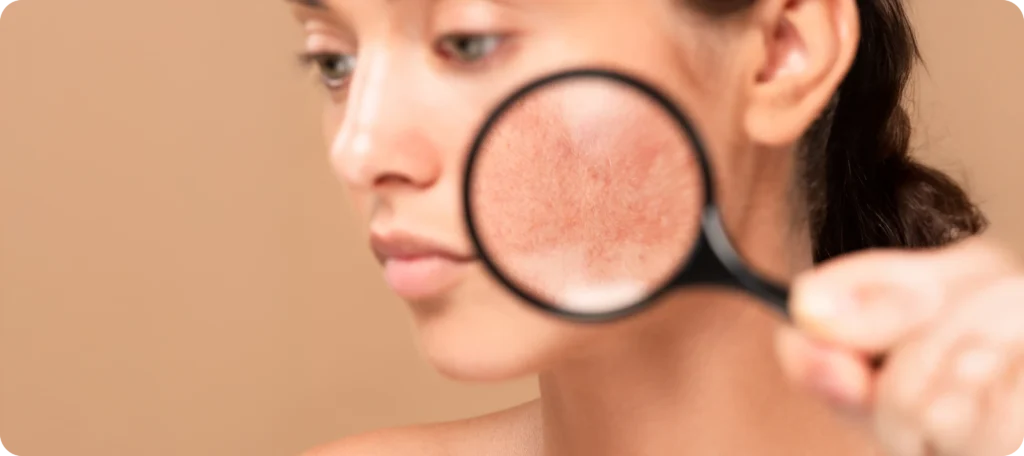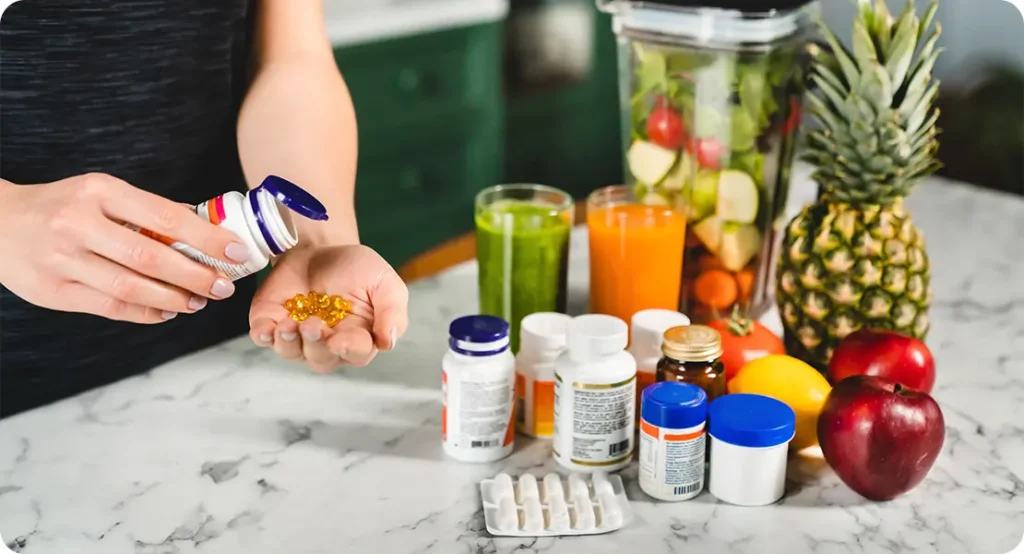Let’s face it—your skin is a mirror of your internal health. And while we’ve long known that hormones, stress, and genetics play major roles in skin conditions like acne and rosacea, there’s growing interest in how your plate affects your face. So, can what you eat really trigger a breakout or flare-up? Or help clear things up?
The link between diet and inflammatory skin conditions has been hotly debated for decades. Some dermatologists used to dismiss it entirely—calling it an old wives’ tale. But not anymore. We now have some solid, peer-reviewed evidence to dig into, especially regarding dairy, sugar, gluten, and nutritional supplements.
Let’s break it all down in plain English and see what the current science actually says.
Acne and Rosacea: Quick Refresher
Before we dive into the research, it’s helpful to quickly understand the difference between acne and rosacea—because they’re not the same thing.
Acne
Acne is a complex skin condition, often misunderstood as simply a problem of “dirty” or oily skin. In reality, it’s driven by a combination of factors: excess sebum (oil) production, abnormal shedding of dead skin cells, colonisation of pores by Cutibacterium acnes (formerly Propionibacterium acnes), and a cascade of localised inflammation.
These factors interact in a kind of vicious cycle—clogged pores trap oil and bacteria, triggering inflammation, which then worsens the blockage and swelling.
Hormones—especially androgens—play a significant role in fuelling this process, which is why acne is so prevalent during puberty and can worsen during hormonal fluctuations.
While acne is most common among teenagers, adult acne has become increasingly prevalent, particularly in women over the age of 25. This adult form of acne tends to concentrate around the lower face, jawline, and chin, and is often more persistent than adolescent acne. Triggers can include hormonal changes related to menstruation, stress, or even certain medications and cosmetics.
Adult acne may also be more inflammatory and take longer to resolve. This is why treatment plans need to be tailored—not just to the type of acne, but also to the patient’s age, skin type, and lifestyle.
Understanding the underlying biology helps demystify acne and steers people away from harsh, ineffective over-the-counter products that can actually worsen the problem.
Rosacea
Rosacea is a long-term inflammatory skin condition that typically affects the central face—cheeks, nose, chin, and forehead. It presents as persistent redness and flushing, along with visible blood vessels (telangiectasia), papules, pustules, and sometimes even swelling or thickening of the skin, particularly around the nose (rhinophyma).
Unlike acne, rosacea doesn’t involve clogged pores or blackheads, and it’s not driven by sebum overproduction. Instead, it’s believed to stem from a combination of abnormal immune responses, vascular hypersensitivity, and dysfunction in the skin’s barrier. People with rosacea often have very reactive skin that becomes red or inflamed in response to minor stimuli.
The triggers for rosacea can be very specific to each individual, but some common culprits include heat, alcohol, spicy foods, emotional stress, and sun exposure. These triggers can cause blood vessels to dilate, leading to flushing and exacerbation of symptoms.

Because the condition is chronic, patients often experience cycles of flare-ups and remissions. Over time, untreated rosacea can worsen and significantly affect one’s quality of life, especially due to its visibility on the face.
While there’s no cure, the good news is that with appropriate skincare, medication, and lifestyle modifications—including dietary changes—many people are able to manage their symptoms effectively and reduce the frequency and intensity of flare-ups.
Now, let’s turn our attention to the food side of things.
Dairy: Friend or Foe?
Dairy has been in the dietary spotlight for acne for a while now. Several observational studies and meta-analyses suggest a link between milk consumption and acne severity—particularly skim milk.
One theory? Milk contains hormones—like insulin-like growth factor 1 (IGF-1)—that may stimulate sebum production and increase inflammation. Skim milk may actually be worse than full-fat milk because it’s more processed and may contain added proteins that influence hormonal activity.
Interestingly, fermented dairy like yoghurt and kefir hasn’t shown the same strong link to acne. In fact, some studies suggest that probiotic-rich dairy may be neutral or even beneficial, thanks to its gut-friendly bacteria. That’s a huge clue: perhaps it’s not dairy per se, but the type of dairy and how your body processes it.
When it comes to rosacea, the evidence is thinner. One large observational study found no strong association between milk intake and rosacea flares, although anecdotal reports from patients suggest that cheese and cream can sometimes trigger redness in sensitive individuals.
Sugar and High-Glycaemic Diets: The Clearer Culprit?
If there’s one dietary villain with more consistent research behind it, it’s sugar—and more specifically, high-glycaemic index (GI) foods.
High-GI foods cause rapid spikes in blood sugar and insulin levels. This cascade may increase androgens (male hormones), stimulate oil glands, and worsen inflammation—all of which can feed into acne formation. Think white bread, fizzy drinks, pastries, and sweets.
Several interventional studies have shown that adopting a low-glycaemic diet (think whole grains, pulses, vegetables, and lean proteins) can significantly reduce acne lesions over time. The improvements are often seen in just a few weeks, which is promising for patients seeking non-pharmaceutical options.
Rosacea is a bit trickier. While there’s less clinical trial data, many sufferers report flare-ups after consuming sugary foods or alcohol—particularly wine. The blood vessel dilation triggered by these foods may be to blame, rather than the sugar itself. Still, keeping blood sugar stable could be helpful overall.
Gluten: Hype or Hidden Trigger?
Gluten often gets blamed for everything—from brain fog to bloating to bad skin. But does it really play a role in acne or rosacea?
For acne, the evidence linking gluten to breakouts is weak. There are no major studies showing a direct connection unless you have coeliac disease or gluten sensitivity. That said, a damaged gut lining (as seen in coeliac patients) may promote systemic inflammation, which could aggravate acne in indirect ways.
With rosacea, the picture is slightly more compelling. A few recent papers have reported a higher prevalence of gastrointestinal disorders, including coeliac disease and IBS, in rosacea patients. Whether this means gluten is a direct trigger or just part of a broader inflammatory response is still up for debate. But some patients do report noticeable improvements in redness and flushing after cutting out gluten.
If you suspect gluten is an issue, the best way to know is to eliminate it for a few weeks and track your skin’s response. Just make sure you don’t fall into the trap of replacing gluten with ultra-processed “gluten-free” junk foods.
The Gut-Skin Axis: A Key Connection
Let’s talk about your gut. Or more precisely, the trillions of bacteria living in it. Your microbiome plays a huge role in modulating inflammation and immune responses—and that includes your skin’s behaviour.
A disrupted gut microbiome (called dysbiosis) can increase intestinal permeability (aka “leaky gut”), allowing toxins and inflammatory molecules to enter the bloodstream. This can trigger skin inflammation and potentially worsen both acne and rosacea.
Several studies have found that people with acne and rosacea tend to have altered gut flora compared to those without. Probiotics—either through supplements or fermented foods—may help restore balance and reduce skin inflammation. Some small trials show improvements in acne severity after taking Lactobacillus and Bifidobacterium strains for a few weeks.
For rosacea sufferers with gut symptoms like bloating or constipation, addressing the gut—through diet, probiotics, or medical treatment—can sometimes dramatically improve skin clarity.
Supplements: What Works, What Doesn’t?
Navigating the world of skin supplements can feel like the Wild West. Let’s cut through the noise and look at what the science actually supports.

Zinc
Zinc is an anti-inflammatory mineral that’s been studied in acne treatment for decades. Several randomised trials show that zinc supplements can reduce both inflammatory and non-inflammatory acne lesions—especially in people with low baseline zinc levels.
Omega-3s
Found in oily fish like salmon, EPA and DHA omega-3 fatty acids have anti-inflammatory properties. Some small studies suggest omega-3 supplementation can help reduce acne severity and possibly rosacea flares as well.
Vitamin A
Vitamin A is crucial for skin health and cell turnover. Oral isotretinoin (a derivative of vitamin A) is a powerful acne drug. But high-dose vitamin A supplements should never be taken without medical supervision—they can be toxic.
Probiotics
As we’ve already discussed, probiotics show promise in improving both gut and skin health. They’re not a cure-all, but for many, they may be a useful addition to a broader skin strategy.
B Vitamins
Be careful here—especially with B12. High-dose B12 has been associated with acne flares in some individuals. It doesn’t happen to everyone, but it’s worth being mindful of if you’ve recently started a B-complex and noticed a breakout.
Anti-Inflammatory Diets: A Unified Approach?
Rather than chasing or cutting individual ingredients, many researchers now recommend looking at dietary patterns as a whole. Enter: the anti-inflammatory diet.
This kind of eating pattern focuses on:
- Colourful vegetables and fruit
- Whole grains
- Lean protein
- Healthy fats (like olive oil, nuts, seeds)
- Limited processed food and sugar
Sound familiar? It’s basically the Mediterranean diet. Several studies have linked this way of eating to improved skin quality, reduced acne severity, and lower inflammation markers overall.
For rosacea, there’s growing support for this approach too. Avoiding triggers (like alcohol and spicy foods) while focusing on anti-inflammatory staples can help keep flares under control.
Food Diaries and Personal Triggers
No two people react exactly the same to food. That’s why keeping a food diary can be so powerful. By tracking what you eat and how your skin behaves over time, you can spot patterns and identify potential triggers—whether it’s cheese, wine, chocolate, or even specific additives.
Don’t forget to factor in things like stress, sleep, and skincare products, too. Diet is just one piece of a very complex puzzle.
The Role of Dermatologists and Nutritionists
If you’re dealing with stubborn acne or rosacea and suspect food might be playing a role, don’t go it alone. There’s no one-size-fits-all answer when it comes to diet and skin health, and self-diagnosing food triggers can lead to a lot of confusion, frustration, and unnecessary restriction.
Partnering with a dermatologist who understands the potential role of nutrition—especially one who works in collaboration with a registered dietitian—gives you the best chance of developing a plan that’s both effective and safe. It also ensures that you’re not chasing myths or cutting foods based on assumptions, rather than evidence.
A medical professional can help you assess whether certain foods truly aggravate your condition or if other lifestyle factors—like stress, skincare, or hormones—are playing a bigger role. With expert guidance, you can explore structured elimination diets if needed, followed by careful reintroduction to identify patterns without compromising your overall nutrition.
This methodical approach avoids guesswork and reduces the risk of developing fear around eating, which can sometimes occur when people try to manage skin conditions through diet alone.

Another major benefit of involving professionals is the prevention of nutrient deficiencies. It’s surprisingly easy to miss out on essential vitamins and minerals when you start eliminating entire food groups. For example, cutting out dairy may lower your intake of calcium and vitamin D, both vital for overall health—not just for bones, but also for the skin’s repair and immune functions.
A dietitian can suggest suitable alternatives or supplements to fill in any gaps, ensuring your skin strategy supports your long-term wellbeing.
Finally, a balanced approach helps reduce the emotional toll that skin conditions often bring. Living with visible inflammation can affect confidence, mental health, and social interactions.
Having a knowledgeable support team who understands your goals—and works with you rather than against you—makes a huge difference. It turns skin management from a lonely guessing game into a structured, empowering process. So if you’re navigating this journey, don’t be afraid to reach out for help. With the right guidance, clearer skin and a healthier relationship with food are well within reach.
Final Thoughts: Diet Matters—But It’s Not Everything
Let’s wrap it up. Diet isn’t the sole cause of acne or rosacea, but it’s increasingly clear that it can influence both conditions in meaningful ways.
If your skin is giving you grief, it’s worth taking a closer look at your plate. Start small—maybe swap sugary snacks for wholefoods, try a low-GI diet for a few weeks, or experiment with reducing dairy. But don’t expect overnight miracles. Give changes time, keep a journal, and most importantly—listen to your body.
And remember: good skin isn’t just about what you cut out. It’s also about what you nourish yourself with. If you are concerned about acne or rosacea, you can contact us at The London Dermatology Centre to book a consultation with one of our expert dermatologists.
References
- Burris, J., Rietkerk, W. and Woolf, K., 2013. Relationships of self-reported dietary factors and perceived acne severity in a cohort of New York young adults. Journal of the Academy of Nutrition and Dietetics, 113(3), pp.431-435.
- Bowe, W.P., Joshi, S.S. and Shalita, A.R., 2010. Diet and acne. Journal of the American Academy of Dermatology, 63(1), pp.124-141.
- Del Rosso, J.Q. and Gallo, R.L., 2013. Rosacea as an inflammatory dermatosis: current concepts. Journal of Clinical and Aesthetic Dermatology, 6(6), pp.14-22. Available at: https://www.ncbi.nlm.nih.gov/pmc/articles/PMC3695434/ [Accessed 16 May 2025].
- Kim, J. and Cho, Y., 2021. Low glycemic load diet reduces the severity of acne vulgaris and regulates the expression of insulin-like growth factor-1. Dermato-Endocrinology, 13(1), p.1871400.
- Holmes, A.D., 2013. Potential role of microorganisms in the pathogenesis of rosacea. Journal of the American Academy of Dermatology, 69(6), pp.1025-1032.
